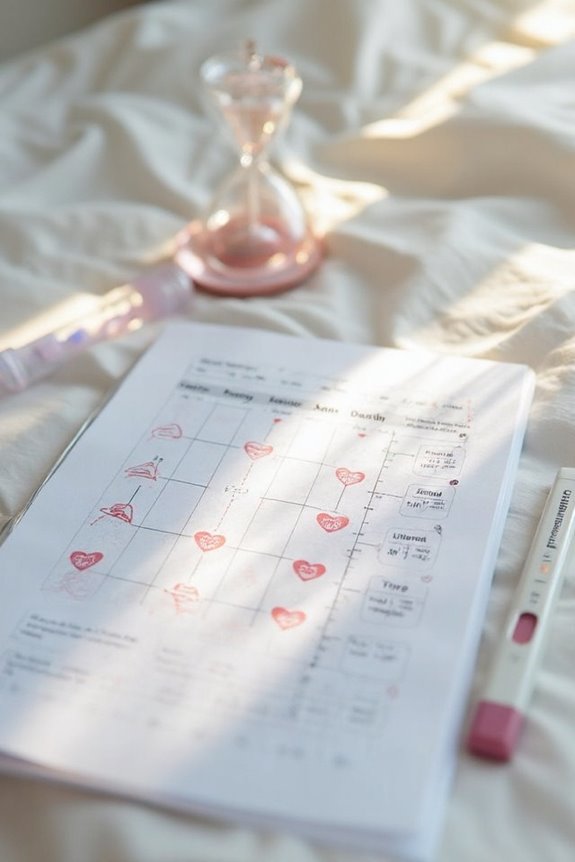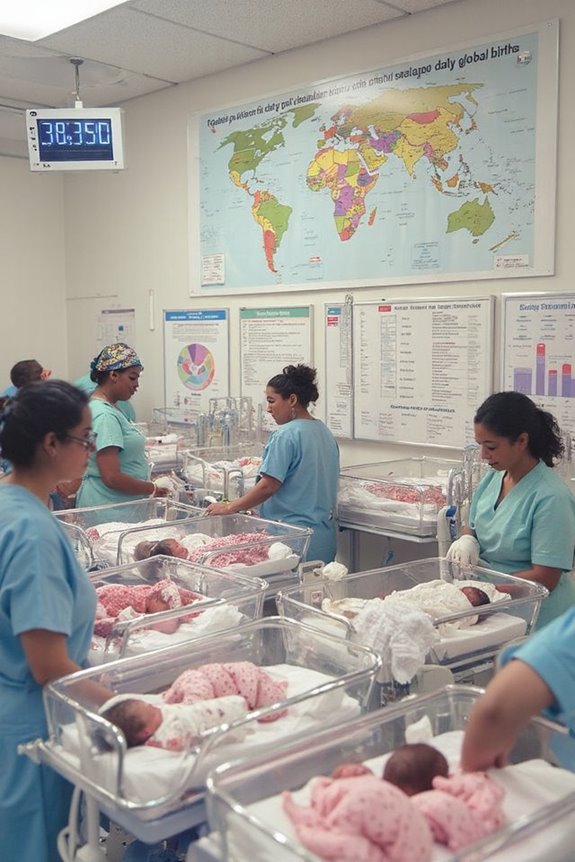To make a baby, timing is critical. Have sex during your fertile window—about six days including ovulation day and five days before. I recommend tracking ovulation using calendar methods, cervical mucus changes, or ovulation predictor kits. Maintain a healthy lifestyle with balanced nutrition, regular exercise, and stress management. If you’re under 35 and trying for 12 months without success (or 6 months if over 35), consult a doctor. The journey to conception involves more factors than many couples initially realize.
Key Takeaways
- Timing intercourse during the fertile window (5 days before ovulation and ovulation day) maximizes conception chances.
- Track ovulation using calendar methods, cervical mucus changes, basal body temperature, or ovulation predictor kits.
- Maintain a healthy lifestyle with balanced nutrition, moderate exercise, and reduced exposure to environmental toxins.
- Sperm can survive up to 5 days in the female reproductive tract while eggs remain viable for 24 hours.
- Seek medical consultation if pregnancy doesn’t occur within 12 months (under 35) or 6 months (35+).
Understanding the Conception Process: From Ovulation to Fertilization
When you’re trying to conceive, understanding the biological processes involved can greatly improve your chances of success. I’ll walk you through the essential steps of conception.
Each month, your ovaries release a mature egg during ovulation—typically two weeks after your period begins. Look for ovulation signs like changes in cervical mucus and slight temperature increases.
The key to fertilization timing:
- Your egg survives only 12-24 hours after release
- Sperm can live up to 5 days in favorable cervical conditions
- Fertilization occurs in the fallopian tube, not the uterus
When sperm meets egg, only one can penetrate and form a zygote containing genetic material from both parents. This fertilized egg then travels to the uterus for implantation, beginning the pregnancy journey.
The Fertile Window: Timing Intercourse for Optimal Results

Now that you understand the biological foundations of conception, let’s focus on identifying your fertile window—the specific days when pregnancy is most likely to occur.
Despite fertile myths you may have heard, conception timing is quite specific. The fertile window spans about six days each cycle:
- The day of ovulation
- The five days before ovulation
Your chances are highest during the three days leading up to and including ovulation. This narrow timeframe exists because:
- Sperm can survive up to five days in your reproductive tract
- Your egg remains viable for only 24 hours after release
I recommend having intercourse once daily during your most fertile days, particularly the two days before ovulation. Using ovulation calculators or tracking cervical mucus changes can help pinpoint this vital window.
Lifestyle Factors That Impact Fertility

Your daily habits and environment play essential roles in your fertility journey, often having as much impact as your biological factors. Let’s explore how your choices affect your reproductive health:
Dietary habits: Maintain a healthy weight through balanced nutrition. Focus on fruits, vegetables, and whole grains while limiting processed foods and sugar.
Exercise routines: Regular, moderate activity improves hormone balance and weight management. However, excessive exercise can disrupt menstrual cycles.
Environmental factors: Limit exposure to pollutants, secondhand smoke, and extreme heat. Curiously, computer use has been linked to improved IVF outcomes in some studies.
Lifestyle choices: Reduce stress through adequate sleep, relaxation techniques, and work-life balance. Consider limiting alcohol and avoiding smoking, as both greatly decrease fertility potential.
Tracking Ovulation: Methods and Tools for Success

Beyond lifestyle adjustments, successful conception often hinges on timing intercourse with ovulation. Let me outline your most effective tracking options:
Basic Methods:
- Calendar tracking of menstrual cycles
- Observing cervical mucus changes (becomes clear and stretchy during fertile days)
- Monitoring basal body temperature (rises after ovulation)
Technology-Enhanced Options:
- Ovulation predictor kits detect luteinizing hormone (LH) surges
- Digital monitors measure hormone levels with high precision
I recommend combining methods for best results. While observing cervical mucus is free and informative, it’s subjective. Digital monitors offer greater accuracy but at higher cost. Many couples find LH test strips provide a good balance of affordability and reliability.
Consider your budget, lifestyle, and accuracy needs when choosing your tracking method.
Nutrition and Supplements for Enhanced Fertility

While tracking ovulation timing is essential, the nutritional foundation you establish can greatly impact your fertility outcomes. I recommend focusing on these key nutritional approaches:
- Follow a Mediterranean diet rich in fruits, vegetables, and whole grains
- Consume folic acid-rich foods like leafy greens for improved fetal development
- Include omega-3 sources such as salmon and walnuts for reproductive health
Nutrient timing matters too—starting supplements at least 3 months before conception allows for ideal cellular development. Evidence supports specific supplements:
- Coenzyme Q10 for improved energy production in reproductive cells
- Vitamin D to reduce miscarriage risk
- Select fertility herbs like green tea for antioxidant benefits
When to Seek Medical Assistance for Conception
Recognizing when to seek professional help can dramatically improve your chances of successful conception if you’ve been trying without success. The timing of fertility evaluations depends primarily on your age:
- Under 35: Consult after 12 months of trying
- 35 and older: Seek help after just 6 months due to declining egg quality
- Known fertility issues: Schedule medical consultations immediately
Approximately 15% of reproductive-age couples experience infertility. Early intervention offers several benefits:
- Higher success rates for treatment
- Reduced emotional stress
- Preservation of existing fertility
- More cost-effective treatment options
Your doctor will begin with an initial consultation followed by appropriate diagnostic tests to identify underlying causes like hormonal imbalances, structural issues, or genetic factors before recommending personalized treatment options.
Alternative Paths to Parenthood: Assisted Reproductive Technologies
When medical assistance becomes necessary for conception, you’ll find several advanced options available through Assisted Reproductive Technologies (ART). These procedures now account for about 2.3% of U.S. births.
The most common ART procedures include:
- IVF procedures, where eggs are fertilized outside the body
- ICSI techniques for cases with male factor infertility
- Embryo transfer after laboratory fertilization
You may also consider:
- Donor options for eggs or sperm
- Surrogate mothers when pregnancy isn’t possible
- Cryopreservation benefits for fertility preservation
ART advancements continue to improve success rates, though global accessibility varies due to regulatory challenges. Technologies like preimplantation genetic testing and time-lapse imaging have enhanced outcomes considerably. If you’re considering ART, consult with a reproductive endocrinologist to discuss which options suit your situation.
Frequently Asked Questions
Can Stress Actually Prevent Conception?
Like a storm on calm waters, I’ve seen stress impact your fertility. High anxiety levels can disrupt hormones, potentially delaying ovulation and affecting implantation, but it’s rarely the sole barrier to conception.
Does Position During Intercourse Affect Chances of Conception?
I’m not seeing evidence that intercourse positions affect your conception chances. Despite popular fertility techniques suggesting otherwise, sperm can swim to the egg regardless of position – timing matters more than posture during sex.
How Soon Can Pregnancy Symptoms Appear After Conception?
I’ve found that early signs of pregnancy can appear as soon as 1-2 weeks after conception. The pregnancy timeline varies, but most women notice symptoms after implantation, around 6-12 days post-fertilization.
Can I Conceive While Breastfeeding Another Child?
Like a hidden clock, your fertility can restart while breastfeeding. Yes, you can conceive while nursing another child, though breastfeeding effects typically delay ovulation timing. Once your periods return, pregnancy becomes increasingly possible.
Does Age Affect the Gender of My Baby?
I’ll tell you what science says about gender predictions: parental age has only a moderate influence. Both older moms and dads may slightly increase chances of having girls, but it’s a small effect overall.
References
https://my.clevelandclinic.org/health/articles/11585-conception
https://www.ncbi.nlm.nih.gov/books/NBK542186/
https://www.webmd.com/baby/ss/slideshow-conception
https://unifiedpremierwomenscare.com/the-science-of-conception-from-egg-to-embryo/
https://en.wikipedia.org/wiki/Human_fertilization
https://www.ucsfhealth.org/education/conception-how-it-works
https://www.thewomens.org.au/health-information/fertility-information/getting-pregnant/ovulation-and-conception
https://myhealth.alberta.ca/Health/pages/conditions.aspx?hwid=tw9234
https://www.acog.org/womens-health/experts-and-stories/the-latest/trying-to-get-pregnant-heres-when-to-have-sex
https://www.yourfertility.org.au/everyone/timing





